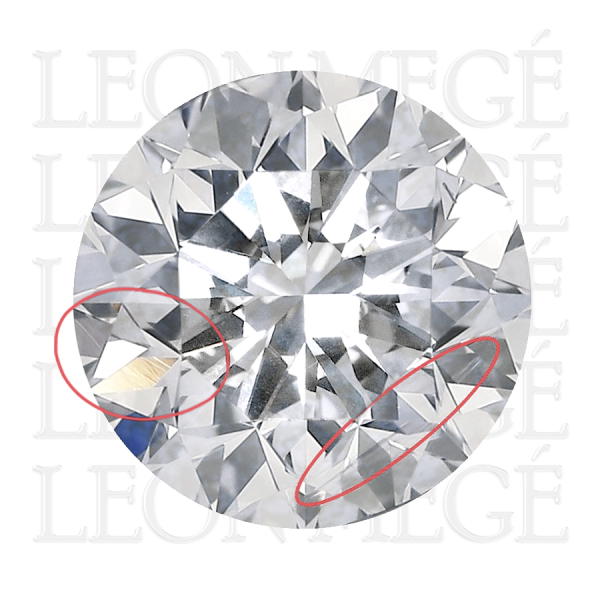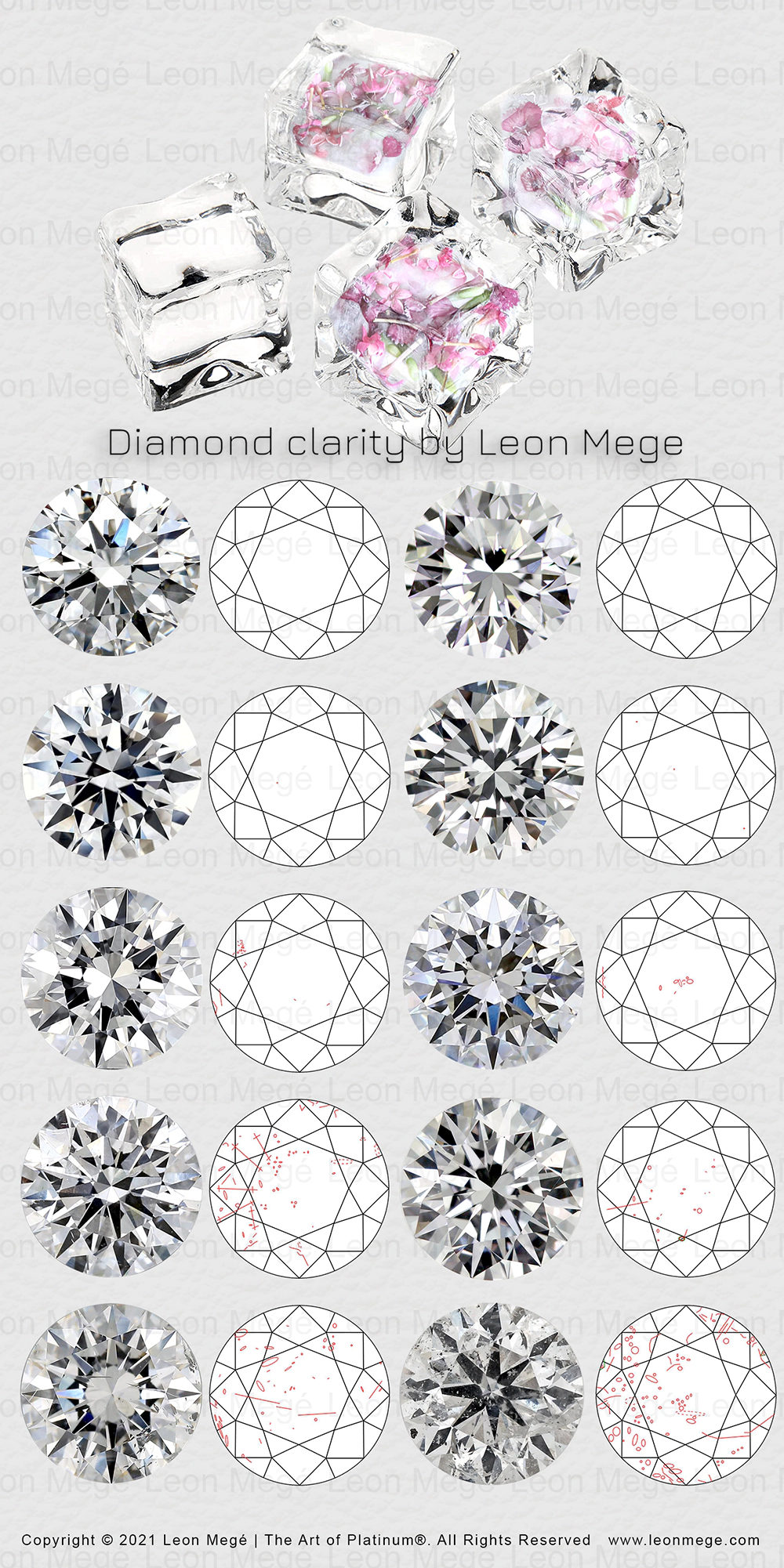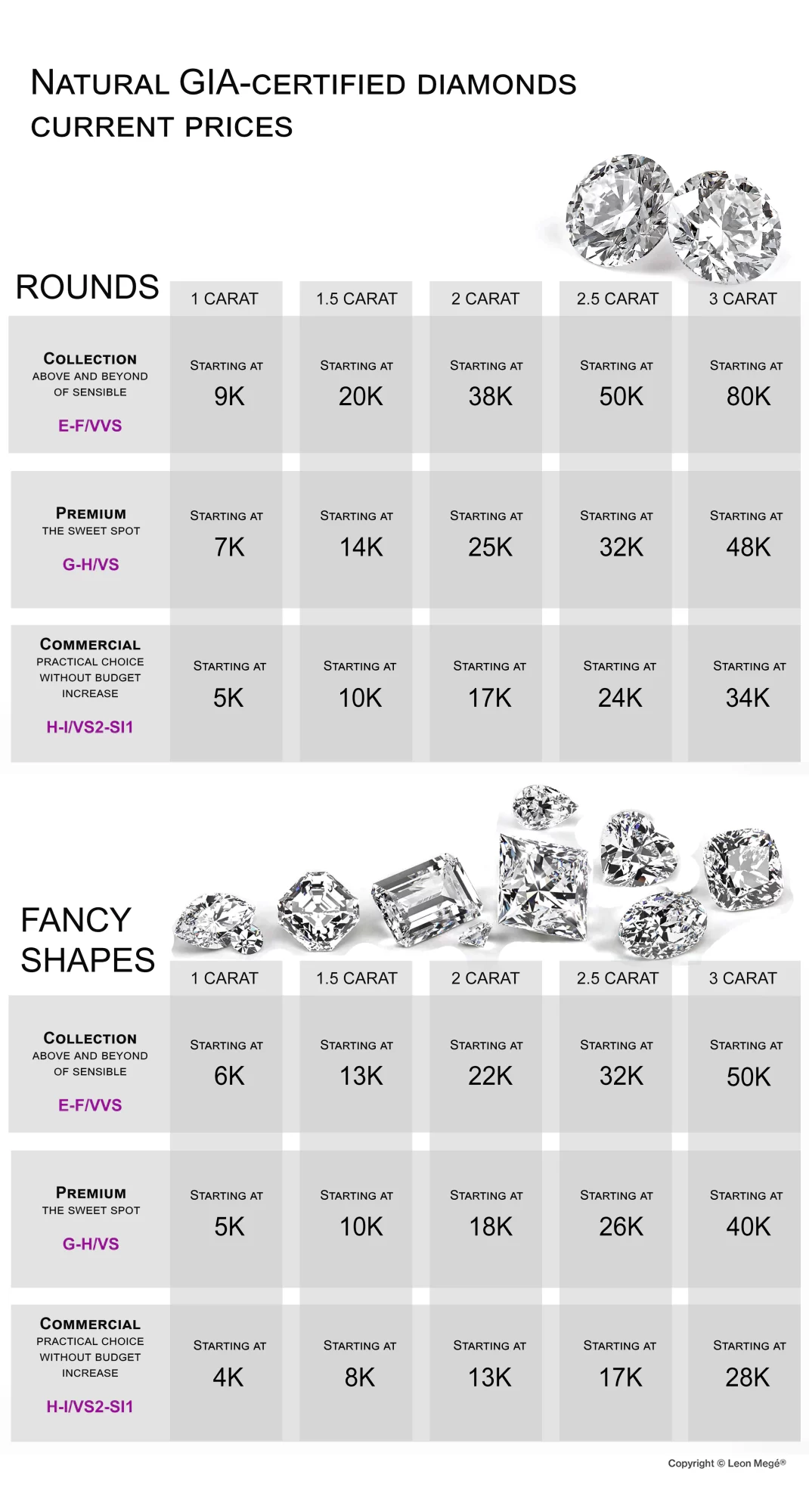What is Diamond Clarity?
Clarity is the presence of foreign matter called inclusions and blemishes in diamonds. Gemologists refer to inclusions as “identifying characteristics” and consider them a diamond’s unique “fingerprint” rather than a nuisance.
Diamond clarity is determined by the number, size, location, and type of inclusions:
- Transparent or opaque crystals called pinpoints
- Groups of pinpoints called clouds
- Internal fractures called feathers
- Internal graining (crystal growth twinning planes)
External blemishes: polishing lines, grain lines, scratches, chips, nicks, and “naturals” (part of the rough diamonds’ original surface).
Diamonds are graded by skilled professionals using natural or artificial light with a 10X loupe corrected for chromatic and spherical aberration or with a 10X binocular microscope equipped with dark-field illumination.
Clarity grades
The universally accepted GIA grading system has a total of eleven grades grouped into six categories:
Flawless (FL) Nothing is visible under 10x magnification. It’s a pure diamond crystal with positively no blemishes or inclusions. Flawless diamonds are generally not used in jewelry. They will most likely develop blemishes during the wear and drop to IF or even the VVS category.
Internally Flawless (IF) No inclusions visible under 10x magnification except minor blemishes. The blemishes can be repolished to bring the clarity grade to the Flawless. The surface grain lines cannot be repolished.
Very, Very Slightly Included (VVS1 and VVS2) Inclusions are so minor (often smaller than specks of dust) that it can take hours for a skilled gemologist to find them under 10x magnification. The difference between VVS1 and VVS2 grades is in the number and location of inclusions. VVS1 diamonds typically have no more than two inclusions on the periphery, while VVS2 inclusions can be closer to the center.
Very Slightly Included (VS1 and VS2) Minor inclusions requiring an effort to see the inclusions under 10x magnification. In step cuts, VS2 inclusions can be noticeable to a person with a sharp eye.
Slightly Included (SI1 and SI2) Inclusions are noticeable under 10x magnification.
Included (I1, I2, and I3) Inclusions are obvious under 10x magnification and, in I2 and below, almost certainly affecting diamond transparency and brilliance. Usually, these inclusions will be centrally located and noticed immediately when the diamond is examined. SI inclusions are usually evident when the stone is placed table-down on a white background but not face-up.
The SI clarity grade is an abbreviation for Slightly Included, according to the GIA clarity grading system. The SI-graded diamonds have readily and immediately visible inclusions under 10x magnification. There are SI1 and SI2 subdivisions according to the severity of the inclusions and their visibility to the naked eye when carefully scrutinized.
Most SI1 brilliant-cut diamonds are eye-clean, but claims that all SI1 diamonds are eye-clean are patently false. Another false claim is spotting inclusions within ideal-cut diamonds is harder because they are brighter and exhibit more sparkle.
All SI diamonds should be evaluated one by one, viewed from a normal distance of 9-12 inches while keeping in mind that the result depends on the observer’s vision. Even when incisions can be seen with an unaided eye, they are not necessarily glaringly obvious. Sometimes the inclusions can be barely made out only at a certain angle. This should be considered when evaluating the overall effect on the stone and reflected in the diamond’s price.
Occasionally some SI2 diamonds, despite being eye-clean, are borderline SI1s. This is rare and can be attributed to GIA personnel having a bad-hair day.
Diamonds with translucent, non-reflective inclusion or inclusions located at the girdle where prongs could cover them are desirable.
Prongs and bezels holding a stone are partially covering it. Strategically placing metal over the inclusion can hide it from view.
There are a few things to consider. Often the inclusion is too big to be covered. Also, some inclusions make a diamond fragile, so applying pressure with a prong during the setting can shatter the stone. And finally, sometimes, it is impossible to cover several inclusions without altering the prong’s position, which can negatively affect the jewel’s look.
An “eye-clean” diamond has no imperfections visible to the unaided eye. However, vision clarity, peripheral awareness, eye coordination, depth perception, focusing ability, and color vision vary from person to person. It makes a clear definition of “eye clean” impossible.
The traditional clarity grading system relies on 10x magnification to define the visibility of the inclusion.
What GIA should have done is to split SI stones into three or even four sub-categories. Unfortunately, they opted for just two, opening the door for creative and totally subjective opinions.
Regardless of their clarity grade, the eye-clean stones offer excellent value to the consumer.
There are only two clarity grades for most consumers: stones that look clean and those with something inside, real or imaginary.
The SI is a watershed grade for brilliant-cut diamonds making a “good SI” a sweet spot for bargain hunters.
For step-cuts, the VS2 grade is where eye-clean stones are mixed with those where inclusions stick out like a vegan at the steak dinner.
- Knot is an exposed crystal breaking the diamond surface.
- Abrasion is the damage from scraping or wearing away edges. Myriads of tiny chips blunt the intersections where facets meet.
- Scratches are scores or marks on the surface caused by contact with another diamond.
- Natural is a leftover section of the rough diamond skin that is left unpolished. Usually, naturals are on the girdle and are often mistaken for chips. Triangular marks called trigons help to identify them as the naturals.
- Nick is a small chip on a girdle or facet.
- – White or transparent polish lines left on the surface after polishing can be easily removed, usually without losing weight. A “drag line” is a deep single polish line.
- Polish marks are hazy areas on the surface caused by excessive heat during polishing.
- Pit is a minute opening on the stone’s surface, usually mistaken for a pinpoint or a speck of dust.
- Grain lines are wavy ripples caused by polishing the crystal’s zone of irregular growth.
- Wavy skin is a transparent rippled texture from polishing a facet against the grain.
- Extra facets are usually added to remove a flaw close to the surface. Additional facets are usually located next to the girdle, where they are less visible.
- Rough girdle is a grainy patch on a polished girdle left unpolished during faceting.
 When external forces deep in the earth’s crust have caused a diamond crystal to grow unevenly, its internal structure is shifted, forming a linear or wavy pattern. The result is similar to heat waves visible when hot and cold air mix. Usually transparent, the graining can be reflective or opaque.
When external forces deep in the earth’s crust have caused a diamond crystal to grow unevenly, its internal structure is shifted, forming a linear or wavy pattern. The result is similar to heat waves visible when hot and cold air mix. Usually transparent, the graining can be reflective or opaque.
Internal graining cannot be removed because it is confined to the diamond interior. Relatively rare, internal graining usually has a minor impact on the overall look of a diamond. Still, internal graining significantly impacts the diamond value, especially when visible through the crown or can be seen with the naked eye.
Surface graining is an irregular diamond structure visible under extremely high magnification when lit up from an acute angle. It appears as faint transparent lines. Surface graining is stated in the comments section of a grading report because it is not an inclusion.
Unlike its brethren, internal graining, surface graining has zero effect on the diamond’s value. Moreover, it is so minor that the only clarity characteristic allowed in a Flawless diamond, according to GIA, is surface graining. In many cases, surface graining can be polished off without weight loss.
If we blow a diamond to the side of the Earth, the graining will be a mound only a few feet high on its surface. It is easier to spot surface graining than a hole inside a wheel of Parmesan.
These are residual markings left behind when the rough crystal is cut by laser. They are minor blemishes on the diamond’s surface or inside the crystalline structure. A manufacturing remnant on the GIA report could also refer to faint burn marks caused by the excessive heat of the polishing wheel. Most of the time, they are not eye-visible and do not affect the diamond’s value.


